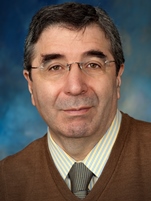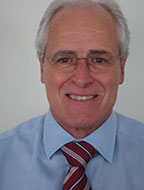2017 SPEAKERS
Ranjan Duara, MD
Organizer
 Dr. Ranjan Duara is the Medical Director and Dennis C. Cole Family Chair in Alzheimer’s Disease Research at the Wien Center for Alzheimer’s Disease and Memory Disorders at Mount Sinai Medical Center in Miami Beach. He is a Professor of Neurology at the Herbert Wertheim College of Medicine (Department of Neurology) at Florida International University and Courtesy Professor of Neurology, University of Florida College of Medicine. He completed internal medicine and neurology residencies in India, the United Kingdom and at Thomas Jefferson University Hospital in Philadelphia, and did a fellowship in neuroscience and neuroimaging at NIH.
Dr. Ranjan Duara is the Medical Director and Dennis C. Cole Family Chair in Alzheimer’s Disease Research at the Wien Center for Alzheimer’s Disease and Memory Disorders at Mount Sinai Medical Center in Miami Beach. He is a Professor of Neurology at the Herbert Wertheim College of Medicine (Department of Neurology) at Florida International University and Courtesy Professor of Neurology, University of Florida College of Medicine. He completed internal medicine and neurology residencies in India, the United Kingdom and at Thomas Jefferson University Hospital in Philadelphia, and did a fellowship in neuroscience and neuroimaging at NIH.
Dr. Duara’s research has focused primarily on early diagnosis of Alzheimer’s disease and other dementias, neuroimaging, genetic epidemiology and the methodology for staging the transition from normal cognitive aging to dementia. He has contributed to over 200 articles in peer-review scientific journals as well many book chapters.
He is the Principal Investigator for the State of Florida Alzheimer’s Disease Initiative Brain Bank and Associate Director of the 1FLORIDA Alzheimer’s Disease Research Center. He has also been an investigator in numerous clinical trials of novel agents for the treatment of Alzheimer’s Disease.
David Borchelt, PhD
Speaker – MCI Symposium, Session 1
 David Borchelt, PhD, has been with the University of Florida since April of 2005 after 13 years on the faculty of Johns Hopkins University School of Medicine. Dr. Borchelt was recruited to the McKnight Brain Institute of UF to direct research in Alzheimer’s disease that has been generously funded by an endowment from SantaFe HealthCare (a division of AvMed, Inc.).
David Borchelt, PhD, has been with the University of Florida since April of 2005 after 13 years on the faculty of Johns Hopkins University School of Medicine. Dr. Borchelt was recruited to the McKnight Brain Institute of UF to direct research in Alzheimer’s disease that has been generously funded by an endowment from SantaFe HealthCare (a division of AvMed, Inc.).
He has authored, or co-authored, more than 150 research papers focusing on human neurodegenerative disorders. Dr. Borchelt received his Ph.D. from the University of Kentucky in 1986 where he studied the regulation of retrovirus gene expression. After receiving his doctorate, Dr. Borchelt worked as a post-doctoral fellow with Dr. Stanley Prusiner at the University of California in San Francisco. In 1999 Dr. Prusiner won the Nobel Prize in Medicine for his work on infectious proteins that cause Mad Cow disease, Cruetzfeldt-Jakob disease, and other neurodegenerative diseases of animals and humans.
The prion hypothesis is built upon the notion that a brain protein can acquire a conformation (a 3-dimensional shape) that then serves as a template to replicate the conformation, essentially transmitting the conformation from one protein to the next, with the abnormal toxic conformation transmitting between cells to spread neural dysfunction. During his time with Dr. Prusiner, Dr. Borchelt produced some of the seminal work on prion protein that supported this hypothesis.
From this work, Dr. Borchelt he began to realize that most human neurodegenerative diseases, including amyotrophic lateral sclerosis, Huntington’s disease, and Alzheimer’s disease, share similarities with prion disease in that the symptoms and pathology are caused by the accumulation of proteins in altered conformations. Recent evidence of transmission of disease pathology and symptoms in mice that model these diseases further establishes the relevance of prion-like mechanisms of protein misfolding to more common neurodegenerative diseases.
.
Prion-like Mechanisms of Disease Progression on Alzheimer’s Disease: New Therapeutic Opportunities
David Borchelt
University of Florida, Gainesville, FL, USA
Over the past decade, it has become increasingly clear that Alzheimer’s disease (AD) is a pathologically complex disorder that evolves over decades. Although the most common pathology of AD is the co-existence of amyloid plaques and neurofibrillary tangles, about 40% of AD cases also show α-synuclein (αS) pathology. It is also common to observe TDP-43 positive inclusions in AD cases. In dominantly inherited forms of AD (fAD), it has become clear that the deposition of Aβ occurs well before the onset of cognitive symptoms and the appearance of tau pathology. Although the order of events may be less obvious in sporadic AD, the perception is that αS and tau pathologies occur as “secondary” events in the evolution of disease for fAD. A growing body of literature suggests that the evolution of intracellular αS and tau pathology may involve a “prion-like” spreading of a misfolded protein conformation along anatomical pathways or between cells in discrete anatomical structures. Moreover, it is now clear that amyloid pathology can also accelerated by seeding the brains of transgenic mice by injecting tissues homogenates of human AD brains. The prion-like properties of these misfolded protein disorders allows us to use a combination of transgenesis and “seeding” to develop models that more faithfully recapitulate the various pathologies of AD. An important feature of these models is that, by seeding, we are able to establish point of origin and then track the spread of pathology to adjacent structures or anatomically connected structures. If misfolded proteins are moving between cells, as our data and data from other laboratories suggest, and if such proteins are exposed to the intercellular space for a significant interval of time, then antibodies directed against these proteins may be able to bind and inhibit further spread. The development of model systems that mimic the spread, or transmission, of human pathology offers an opportunity to test novel immune therapies to provide proof of concept for moving such therapies to humans.
Maria Carrillo, PhD
Keynote Speaker – Public Educational Forum
 Maria Carrillo, PhD, is Chief Science Officer, Medical and Scientific Relations, at the Alzheimer’s Association. Dr. Carrillo has a wide range of responsibilities, including oversight of the Association’s grant making process and communication of scientific findings within and outside of the organization.
Maria Carrillo, PhD, is Chief Science Officer, Medical and Scientific Relations, at the Alzheimer’s Association. Dr. Carrillo has a wide range of responsibilities, including oversight of the Association’s grant making process and communication of scientific findings within and outside of the organization.
Dr. Carrillo directly manages several Alzheimer’s Association initiatives, including the Research Roundtable, the World-Wide Alzheimer’s Disease Neuroimaging Initiative (WW-ADNI), and the Global Alzheimer’s Association Interactive Network.
She is co-author of the National Institute on Aging–Alzheimer’s Association revised criteria for the diagnosis of Alzheimer’s, and the Appropriate use Criteria for Amyloid imaging. She is on the Advisory Committee for the World Health Organization Dementia Setting Priorities & Portfolio Analysis.
KEYNOTE LECTURE: Research to Clinic–Alzheimer’s Disease Participation in Clinical Trials
Maria Carrillo
Alzheimer’s Association, Chicago, IL, USA
An estimated 47 million people worldwide are living with dementia in 2015 and this number is expected to triple by 2050. There is a clear urgency for therapies and / or interventions to slow or stop or prevent dementia. The current landscape of clinical trials suggests a multitude of approaches are on-going today and continuing to grow – testing strategies to reduce the risk of cognitive decline and possibly dementia through behavioral modifications; expanding diversity of pharmacological targets; exploring potential prevention to stop or slow the progression of Alzheimer’s and related dementias. In addition, clinical studies like the IDEAS study are ground breaking in this field, providing essential information to demonstrate utility of diagnostic tools like Amyloid-Beta PET Imaging on patient-centered outcomes. Participants for these studies are an essential component to our success; emerging data suggest the positive side of participation for the individual volunteer and for the larger field.
Rosie Curiel, PsyD
Speaker – Workshop
 Dr. Rosie Curiel, is an Assistant Professor and Neuropsychologist at the University of Miami Miller School Of Medicine, Department of Psychiatry and Behavioral Sciences, and faculty of the Center on Aging.
Dr. Rosie Curiel, is an Assistant Professor and Neuropsychologist at the University of Miami Miller School Of Medicine, Department of Psychiatry and Behavioral Sciences, and faculty of the Center on Aging.
She specializes in the cognitive and functional assessment of individuals with brain compromise due to various etiologies, and has an expertise in diagnosing neurodegenerative diseases of the brain such as Alzheimer’s disease and related disorders. She also has an expertise in cross-cultural neuropsychological assessment.
Her research interests center upon the development of new and refined ways to assess cognition in older adults; particularly individuals who are at risk for developing Alzheimer’s disease. She is an active Co-Investigator on several large National Institute of Health funded longitudinal studies that compare the utility of traditional assessment methodologies with innovative tools to detect preclinical disease states that are related to markers of biological markers of disease pathology including neuroimaging, blood and cerebrospinal fluid markers. Dr. Curiel is also skilled in treating individuals with acute and chronic spinal cord injuries and is part of the research team for the Human Clinical Trials Initiative at the renowned Miami Project to Cure Paralysis.
Neuropsychological Test Performance in Spanish and English Speakers with Normal Cognition and MCI
Rosie Curiel
University of Miami, Miami, FL, USA
There is an increasing need to develop new cognitive tests to diagnose Alzheimer’s disease (AD) in its preclinical stages. Our laboratory and others have been working to develop novel paradigms that stress the cognitive system to capture the subtle deficits inherent in early disease states. A priority has been to adapt these paradigms to address the ever-growing need to properly assess Spanish-speaking older adults in the United States and abroad. We describe the utility of the LASSI-L, a cognitive stress test that taps proactive semantic interference, retroactive interference, and uniquely, the ability to recover from proactive semantic interference in Spanish-speaking versus English-speaking older adults with amnestic MCI (aMCI) and normal cognition (NC). In addition, we will also present data obtained from our colleagues in Spain regarding the LASSI-L’s psychometric properties and its utility in the detection of early Alzheimer’s disease. The development of additional cognitive stress paradigms for Spanish-speaking elders will be discussed.
Steven DeKosky, MD
Chair – MCI Symposium Session 3
 Steven DeKosky, MD, is the Aerts-Cosper Professor of Alzheimer’s Research at the University of Florida College of Medicine, and is Deputy Director of the McKnight Brain Institute, positions to which he was appointed in July 2015. He also serves as Associate Director of the National Institute of Aging- funded Florida Alzheimer’s Disease Research Center at UF. His academic appointment is as Professor of Neurology in the UF College of Medicine.
Steven DeKosky, MD, is the Aerts-Cosper Professor of Alzheimer’s Research at the University of Florida College of Medicine, and is Deputy Director of the McKnight Brain Institute, positions to which he was appointed in July 2015. He also serves as Associate Director of the National Institute of Aging- funded Florida Alzheimer’s Disease Research Center at UF. His academic appointment is as Professor of Neurology in the UF College of Medicine.
His basic research centers on structural and neurochemical changes in human brain in aging and dementia and effects of traumatic brain injury (TBI). His clinical and translational research have centered on understanding the genetics, neuropsychiatric symptoms, neuroimaging, and treatment and prevention of AD. Beginning trauma studies as a Principal Investigator in the University of Pittsburgh Brain Trauma Research Center in 1992, he studied similarities in the injury cascades of TBI and AD. He was an author of the first reports of Chronic Traumatic Encephalopathy (CTE) in American professional football players. He was also a Principal Investigator in the clinical application of the breakthrough amyloid-imaging agent Pittsburgh Compound B (PiB). He directed an 8 year NIH-funded national multicenter trial to assess whether Ginkgo biloba can prevent or delay onset of dementia in normal elderly adults, the first large study of prevention of dementia/AD.
Dr. DeKosky has served on and led numerous NIH review and advisory committees, and taught and mentored in clinical research training programs sponsored by the National Institute on Aging (NIA) and the National Institute of Neurological Disorders and Stroke (NINDS). He was a member of the FDA Peripheral and Central Nervous System Drugs Advisory Committee from 2004-2007. In 2010 he was appointed to the National Advisory Council of the National Center for Complementary and Alternative Medicine (now the National Center for Complementary and Integrative Health) of the NIH. Following that term, he was appointed to and currently serves on the NIH’s Council of Councils in 2013; the Council of Councils oversees the Common Fund of the NIH.
He is the founding Chair of the Advisory Council of ISTAART, the International Society to Advance Alzheimer’s Disease Research and Treatment. He lectures nationally and internationally on multiple dimensions of Alzheimer’s Disease, including the cognitive, neurobehavioral, genetic, imaging, and basic research underpinnings of the disease.
He has published over 400 peer-reviewed articles and book chapters and serves on the editorial boards of several leading neurology and Alzheimer’s journals and is a reviewer for multiple other journals. He is a Fellow of the American College of Physicians, the American Neurological Association, and the American Academy of Neurology.
Anne Fagan, PhD
Speaker – MCI Symposium, Session 2
 Anne Fagan, PhD, is a Professor of Neurology at Washington University School of Medicine in St. Louis.
Anne Fagan, PhD, is a Professor of Neurology at Washington University School of Medicine in St. Louis.
Her research interest in is fluid biomarkers of Alzheimer Disease, especially during the preclinical (asymptomatic) period.
Dr. Fagan joined Washington University in 1995 and was instrumental in developing the biomarkers program at the Knight Alzheimer’s Disease Research Center (ADRC). She is an ADRC investigator and serves as the Biomarker Core Leader for the Adult Children Study that supports all ADRC-related projects, as well as the international Dominantly Inherited Alzheimer Network (DIAN) of autosomal-dominant AD and its affiliated prevention trial (DIAN Trials Unit).
CSF Predictors of Disease Progression
Anne Fagan
Washington University School of Medicine, St Louis, MO, USA
Alzheimer’s disease (AD) pathophysiology is a continuous process that likely starts with dysregulation of Aβ metabolism followed by the spreading of tangle pathology from medial temporal regions to association cortices and associated neuronal cell dysfunction and eventual death. Data from clinicopathological and biomarker studies support the existence of a long asymptomatic (preclinical) period during which amyloid plaques and tangles begin to accumulate but without significant neuronal cell loss. It is hypothesized that once a critical threshold of amyloid and tangle pathology is reached, neural damage ensues and appreciable neuronal and synaptic losses occur and mark the transition to symptomatic AD. Cerebrospinal fluid (CSF) biomarker data support this hypothesis in that presence of brain injury markers, including elevations in CSF levels of tau, p-tau181 and the neuronal calcium sensor protein, VILIP-1, strongly correlate with cognitive decline and predict progression to symptomatic AD in individuals with Mild Cognitive Impairment (MCI) and cognitively normal individuals with evidence of cerebral beta-amyloidosis. Novel CSF markers of synaptic integrity (Neurogranin and SNAP-25) are also now being evaluated for their potential utility in predicting clinical disease progression in both mildly impaired and cognitively normal individuals. If successful, the ability to provide individual-level prediction of the development of symptomatic AD will be enormously important both scientifically (e.g., to elucidate the mechanisms that disrupt neural integrity) and clinically (e.g., to eventually provide transitioning persons with future disease-modifying therapies for AD). Moreover, future secondary prevention trials can selectively target these high risk persons to notably reduce sample sizes and trial duration.
Adam Fleisher, MD
Speaker – MCI Symposium, Session 2
 Adam Fleisher, MD, currently serves as Clinical Research Physician and Medical Fellow of Phase III global Trials, and previously as Director of Global Medical Affairs, Alzheimer’s team, for Eli Lilly.
Adam Fleisher, MD, currently serves as Clinical Research Physician and Medical Fellow of Phase III global Trials, and previously as Director of Global Medical Affairs, Alzheimer’s team, for Eli Lilly.
From 2008-2014, Dr. Fleisher was the Director of Imaging at Banner Alzheimer’s Institute where he managed the imaging center and cyclotron facility, the computational imaging laboratory, and functioned as a site investigator for dementia clinical trials, and cared for patients in the Stead Family memory clinic. Previously, he held an academic appointment as an Associate Professor, Department of Neurosciences, at the University of California, San Diego (UCSD), where he served as the Medical Director of the Alzheimer’s Disease Cooperative Study from 2003-2013.
Dr. Fleisher received his medical degree from the University of Rochester School of Medicine, New York, and obtained his general neurology training at Johns Hopkins Hospital in Baltimore, Maryland. He then completed a clinical and research dementia fellowship at UCSD, as well as a Master’s degree of advanced studies in clinical research administration. Dr. Fleisher is published in both MRI and PET imaging (FDG and Amyloid), as well as clinical trials in Alzheimer’s disease, with a research focus on influences of aging and genetic risk factors for Alzheimer’s disease and predictive biomarker development in cognitively normal elderly adults.
Imaging Predictors of Progression (Amyloid and Tau PET)
Adam Fleisher
Eli Lilly & Co., Inc., Indianapolis, IN, USA
Fibrillar amyloid plaques and hyper-phosphorylated tau are believed to be the two primary pathologies underlying neurodegeneration in Alzheimer’s disease. Accurate clinical diagnosis without the support of pathological biomarkers has proven challenging, particularly in the earlier clinical phases of the disease. The advent of PET imaging that identifies these key pathologies has the potential to aid as diagnostic biomarkers. Such markers can be of great value in the clinic, but also for enrollment in disease modifying treatment trials that target tau and amyloid as their mechanisms of action. Proper diagnosis and understanding the presence, amount, and specific distribution of these biomarkers have great potential to inform us about expected progression of the disease, both clinical and neurodegenerative. Predicting future outcomes is a critical part of development of disease modifying therapies and patient care management. A substantial literature has now grown for understanding how amyloid PET can predict disease progression. And now, tau PET adds another layer to our understanding of how to predict future outcomes. This presentation will review the literature and present new trial data in our evolving understanding of how tau and amyloid PET interact to serve as tools for predicting disease progression.
Mary Ganguli, MD, MPH
Speaker – Public Educational Forum
 Dr. Mary Ganguli, MD, MPH, is a geriatric psychiatrist and psychiatric/neuroepidemiology at the University of Pittsburgh, where she teaches residents, fellows, and graduate students. She provides geriatric psychiatry outpatient services at the University of Pittsburgh Medical Center.
Dr. Mary Ganguli, MD, MPH, is a geriatric psychiatrist and psychiatric/neuroepidemiology at the University of Pittsburgh, where she teaches residents, fellows, and graduate students. She provides geriatric psychiatry outpatient services at the University of Pittsburgh Medical Center.
Dr. Ganguli has been conducting population-based studies of cognitive impairment and dementia since 1987. She served on the Neurocognitive Disorders Work Group of DSM-5, and is a member of the AAN Practice Parameter Work Group on MCI. She previously served on the National Advisory Council on Aging. Dr. Ganguli is Associate Editor of the Journal of the American Geriatrics Society and of International Psychogeriatrics, and an Editorial Advisory Board member of Alzheimer Disease and Associated Disorders.
Declining Incidence of Alzheimer’s Disease – Is it Real?
Mary Ganguli
University of Pittsburgh School of Medicine, Pittsburgh, PA, USA
In many high-income countries, where life expectancy is long, studies are starting to show that the incidence of Alzheimer’s disease (AD) is starting to decrease.
What could this mean, and can it be real?
Doesn’t it seem to us that there are more people with AD all the time?
To understand this conundrum we have to first learn the technical meanings of two words.
Incidence is the rate at which new cases of the disease develop in the population.
Prevalence is the proportion of people with the disease in the population at any given time.
The relationship between incidence and prevalence is how long people live with the disease.
People in the US are living longer on average than they used to. So, even if fewer new cases are developing in the population (incidence), they are surviving longer, so there is no decrease in the percentage of older people with disease (prevalence).
Why might incidence be coming down? Maybe it’s because people with AD in their brains are not developing symptoms for a longer time, because they have good “brain reserve.” If so, the reasons might be that today older people have had better education, better health care, better lifestyles than people a generation ago. However, these may be the same factors that lead people to live longer than their parents did.
We will review the studies and discuss their implications.
Todd Golde, MD, PhD
Chair – MCI Symposium Session 1
 Todd Golde, MD, PhD, is a Professor of Neuroscience at the University of Florida and director of the Evelyn F. and William L. McKnight Brain Institute.
Todd Golde, MD, PhD, is a Professor of Neuroscience at the University of Florida and director of the Evelyn F. and William L. McKnight Brain Institute.
Dr. Golde received his MD PhD from Case Western Reserve University. He completed a residency in Laboratory Medicine at University of Pennsylvania. After beginning his independent career at University of Pennsylvania, he moved to Mayo Clinic Florida where he rose from Assistant Professor of Pharmacology to both Professor of Neuroscience and chair of Mayo Clinic’s internationally recognized Department of Neuroscience.
Dr. Golde has published over 180 peer-reviewed manuscripts which have been cited over 15000 times. Dr. Golde is well known for his translational research in Alzheimer’s disease and his work on g-secretase modulators and immunotherapy for neurodegenerative diseases. His scientific honors include the Paul Beeson Faculty, a Alzheimer’s Association Zenith, and MetLife Foundation Awards.
Vladimir Hachinski, MD, DSc
Speaker – Workshop
 Vladimir Hachinski, MD, DSc, FRCPC, FRSC, Distinguished University Professor of Neurology Western University, Canada, earned an MD from the University of Toronto and trained in neurology and research in Montreal, Toronto, London, U.K. and Copenhagen.
Vladimir Hachinski, MD, DSc, FRCPC, FRSC, Distinguished University Professor of Neurology Western University, Canada, earned an MD from the University of Toronto and trained in neurology and research in Montreal, Toronto, London, U.K. and Copenhagen.
Dr. Hachinski along with Dr. John W Norris pioneered the world’s first successful acute stroke unit and discovered vital and fatal brain/heart relationships. He also can be credited alongside David Cechetto and Shawn Whitehead with discovering treatable links between Alzheimer’s disease and stroke.
Dr. Hachinski has authored, co-authored or co-edited 17 books and over 600 publications cited over 29,000 times. He was Editor-in-Chief of STROKE and President of the World Federation of Neurology.
Workshop Concluding Remarks
Vladimir Hachinski
Western University, London, ON, Canada
Jason Hassenstab, PhD
Speaker – MCI Symposium Session 2
 Jason Hassenstab, PhD, is the Cognition Core director for the Dominantly-Inherited Alzheimer Network-Trials Unit (DIAN-TU) and directs cognition for the DIAN observational study. He is currently an Assistant Professor of Neurology and Psychology at Washington University in St. Louis, where he also directs neuropsychological efforts for the Charles F. and Joanne Knight Alzheimer’s Disease Research Center.
Jason Hassenstab, PhD, is the Cognition Core director for the Dominantly-Inherited Alzheimer Network-Trials Unit (DIAN-TU) and directs cognition for the DIAN observational study. He is currently an Assistant Professor of Neurology and Psychology at Washington University in St. Louis, where he also directs neuropsychological efforts for the Charles F. and Joanne Knight Alzheimer’s Disease Research Center.
His research is focused on detection of cognitive changes in the earliest stages of Alzheimer’s disease and their relationship to fluid biomarkers and neuroimaging indicators of Alzheimer’s disease pathology. He also has a vested interest in prevention and treatment research, and is currently funded by NIH to investigate how weight loss and improvements in metabolic functioning impact neurocognitive functioning and risk of developing Alzheimer’s disease.
Dr. Hassenstab is also developing remote cognitive assessment techniques using ecological momentary assessment and measurement burst designs for use in cohort studies and clinical trials. He completed a bachelor’s degree in Jazz and Contemporary Music Performance from New York University and a PhD in psychology under mentorship of Dr. Antonio Convit at New York University School of Medicine and Fordham University. He then completed an NIH-sponsored Kirchstein National Research Service Award Postdoctoral Fellowship at Brown University with Drs. Ronald Cohen, Lawrence Sweet, and Steven Salloway. He joined the faculty at Washington University in St. Louis in 2010.
Dr. Hassenstab will co-present with Dr. McDade
Longitudinal Progression of Biomarkers and Clinical Symptoms in Dominantly Inherited AD
Eric McDade, Jason Hassenstab
Washington University in St. Louis, St. Louis, MO, USA
Dominantly inherited Alzheimer’s disease mutations converge on enzymatic processing of the amyloid precursor protein resulting in the early development of cerebral beta-amyloidosis and the onset of dementia typically in the 4-6th decades. The uniformity of causal mechanisms and similar age of onset within families and within specific mutations combine to provide a predictable staging of Alzheimer’s disease pathobiology throughout the disease course, and allows a uniquely detailed examination of the presymptomatic phases of Alzheimer’s disease. We will discuss the patterns of longitudinal change in cognition and Alzheimer’s disease biomarkers from the Dominantly Inherited Alzheimer Network (DIAN) and describe similarities and differences with sporadic Alzheimer’s disease. These data demonstrate how dominantly inherited Alzheimer’s disease is an ideal model for describing the dynamic associations between biomarkers and their relationship to cognitive decline and disease progression.
Michael Howell, PhD
Speaker – MCI Symposium Session 3
Michael Howell, MD, is an Associate Professor of Neurology at the University of Minnesota. He is the Division Head of Sleep Medicine in the Department of Neurology and the Program Director of the Sleep Medicine Fellowship of the Minnesota Regional Sleep Disorders Center. He is the Medical Director of the Fairview Sleep Center in Edina Minnesota and a Fellow of both the American Academy of Neurology and the American Academy of Sleep Medicine.
Dr. Howell’s research and discovery work is focused upon the relationship between REM sleep behavior disorder (RBD) and neurodegenerative diseases, in particular Parkinson’s disease and other disorders of alpha-synuclein pathology. The ultimate goal of these investigations is to help develop disease-modifying therapies that impede, halt or ultimately reverse Parkinson’s disease.
REM Sleep Behavior Disorder and Neurodegenerative Disease
Michael Howell
University of Minnesota, Minneapolis, MN, USA
Under normal physiological conditions rapid eye movement (REM) sleep is characterized by active dream mentation and skeletal muscle paralysis. However, early alpha-synuclein pathology in the pontine regions that control REM sleep can result in a failure of the brain to maintain muscle paralysis. This leads to the vigorous dream enactment of REM sleep Behavior Disorder (RBD) often characterized by thrashing, punching and kicking. Alpha-synuclein pathology then spreads to other brain regions and frequently leads to Parkinson’s disease, dementia with Lewy bodies or multiple system atrophy. RBD is common, with a world-wide prevalence of approximately 35 million. Recent estimates suggest that up to 90% of surviving RBD patients will ultimately develop a neurodegenerative disorder and thus RBD represents a prodromal syndrome uniquely suited for the development of neuroprotective therapies.
Jeffrey Iliff, PhD
Keynote Speaker – MCI Symposium Session 3; Speaker – Public Educational Forum
 Jeffrey Iliff, PhD, completed his undergraduate degree at the University of Washington and his PhD in Physiology and Pharmacology at Oregon Health & Science University. Then, as a postdoc in the lab of Maiken Nedergaard at the University of Rochester Medical Center, Dr. Iliff helped to define the “glymphatic” system, a brain-wide network of perivascular spaces that facilitates the clearance of wastes, including amyloid beta and tau, from the brain interstitium. In a 2013 study named one of Science magazine’s ‘Top 10 Breakthroughs of 2013’, this team reported that glymphatic function is a feature of the sleeping brain, suggesting that the perivascular clearance of wastes may underlie the restorative function of sleep.
Jeffrey Iliff, PhD, completed his undergraduate degree at the University of Washington and his PhD in Physiology and Pharmacology at Oregon Health & Science University. Then, as a postdoc in the lab of Maiken Nedergaard at the University of Rochester Medical Center, Dr. Iliff helped to define the “glymphatic” system, a brain-wide network of perivascular spaces that facilitates the clearance of wastes, including amyloid beta and tau, from the brain interstitium. In a 2013 study named one of Science magazine’s ‘Top 10 Breakthroughs of 2013’, this team reported that glymphatic function is a feature of the sleeping brain, suggesting that the perivascular clearance of wastes may underlie the restorative function of sleep.
Dr. Iliff’s recent studies have demonstrated that the glymphatic system fails in the aging brain and in the young brain after traumatic brain injury (TBI). These studies suggest that impairment of glymphatic function may be one factor that renders the aging brain vulnerable to protein aggregation and neurodegeneration and may link brain trauma early in life with the development of dementia in the decades that follow.
In 2015 Dr. Iliff was named a Paul G. Allen Family Foundation Distinguished Alzheimer’s Disease Investigator. Ongoing work in his lab seeks to define the molecular and cellular underpinnings of impaired glymphatic function in the aging and post-traumatic brain, and to use novel MRI-based imaging approaches to extend these findings into clinical Alzheimer’s disease and post-traumatic populations.
KEYNOTE LECTURE: The Glymphatic System, Sleep and Neurodegeneration
Jeffrey Iliff
Oregon Health & Science University, Portland, OR, USA
While aging is the strongest risk factor for the development of Alzheimer’s disease, disruption of normal sleep patterns has long been associated with aging and more recently has been associated with the development of Alzheimer’s pathology. Recently, a brain-wide perivascular network termed the ‘glymphatic’ system, has been characterized that facilitates the clearance of interstitial solutes including amyloid beta and tau from the brain. Interestingly, this function was active primarily in the sleeping brain, and is impaired in both the aging and the post-traumatic brain, suggesting one possible basis for the link between aging, sleep disruption and neurodegenerative processes. New data from human clinical subjects suggests that changes in the in elements of the glymphatic system, including the astroglial water channel aquaporin-4 (AQP4) are associated with Alzheimer’s status and pathology, and neurocognitive decline. These findings suggest that glymphatic insufficiency may be one feature of the aging brain that renders it vulnerable to protein mis-aggregation in neurodegenerative conditions such as Alzheimer’s.
The Glymphatic System and the Brain
Jeffrey Iliff
Oregon Health & Science University, Portland, OR, USA
Every person knows from their own experience that sleep refreshes the mind and the lack of it leaves the mind murky. The basis for this restorative function of sleep has remained a persistent mystery of neuroscience since ancient times. However recent experimental studies have shown that when the brain goes to sleep, it shifts into a ‘cleaning mode’, recirculating the fluid that surrounds it (cerebrospinal fluid, CSF) back through the brain tissue along a pathway termed the ‘glymphatic system’ to clear away wastes that have accumulated between the brain’s cells throughout the waking day. This housekeeping function may be one of the key reasons for the evolution of sleep. One of the wastes that the glymphatic system clears out of the brain is the protein amyloid beta, which is made in the brain all the time, but begins to accumulate in patients with Alzheimer’s disease, the leading cause of dementia. This buildup of amyloid beta is believed to be one of the key steps in the onset of this terrible disease. More recent work shows that the glymphatic system begins to fail as the brain ages, slowing the clearance of the protein amyloid beta. Linking sleep, aging and neurodegeneration, this change may be one key factor that sets the stage for protein aggregation in the aging brain and may promote the development of Alzheimer’s disease.
David Loewenstein, PhD, ABPP
Chair – Public Educational Forum; Speaker – Workshop
 David Loewenstein, PhD, is Director of Neuropsychology and Professor of Psychiatry and Behavioral Sciences at the Miller School of Medicine at the University of Miami. He has been actively involved in collaborative research with Dr. Ranjan Duara and other scientists at the Wien Center for Alzheimer’s Disease and Memory Disorders at Mount Sinai Medical Center, Miami Beach Florida where Dr. Loewenstein served as Director Neuropsychology Laboratories and Research Director for over 20 years.
David Loewenstein, PhD, is Director of Neuropsychology and Professor of Psychiatry and Behavioral Sciences at the Miller School of Medicine at the University of Miami. He has been actively involved in collaborative research with Dr. Ranjan Duara and other scientists at the Wien Center for Alzheimer’s Disease and Memory Disorders at Mount Sinai Medical Center, Miami Beach Florida where Dr. Loewenstein served as Director Neuropsychology Laboratories and Research Director for over 20 years.
Dr. Loewenstein has a number of research interests centering on the early detection of early cognitive impairment in neurodegenerative and other brain disorders, development of novel cognitive and functional measures, examining relationships between neuropsychological measures, neuroimaging and other biomarkers of early Alzheimer’s disease. Further, Dr. Loewenstein and other investigators in his laboratory have been involved in developing cognitive and functional interventions for normal elderly patients as well as those with Alzheimer’s disease and related disorders.
The Development of Novel Cognitive Stress Paradigms for Detection of Early Cognitive Impairment in Cross-Cultural Research
David Loewenstein, PhD, ABPP
University of Miami Miller School of Medicine, Miami, FL, USA
Traditional measures of memory function that have been employed for numerous decades, are unfortunately, insufficiently sensitive to detect the earliest cognitive manifestations of Alzheimer’s Disease (AD). Our laboratory has worked on the development of novel paradigms designed to be cognitive stress tests for the detection of early AD. These paradigms are analogous to an exercise electrocardiogram which measures the capacities of the heart when stressed, as opposed to a resting state.
One of our cognitive stress instruments, the LASSI-L has shown excellent psychometric properties and has distinguished individuals with both mild cognitive impairment (MCI) and AD, from cognitively normal (CN) elders. We present data that indicates that older adults with PreMCI states can be differentiated from CN on the basis of their LASSI-L scores. More importantly, data from PET scans indicate that elders with normal scores on traditional neuropsychological measures with increased total and regional amyloid load (e.g., precuneus, posterior cingulate) are strongly associated with failure to recover from proactive semantic interference (PSI). Further research with aMCI patients shows that reduced volumes in Alzheimer’s sensitive regions are also sensitive to the failure to recover from PSI.
The LASSI-L offers advantages over traditional cognitive paradigms in that it a) uses controlled learning; b) uses semantic cues at both encoding and retrieval; c) maximizes proactive semantic interference effects; d) assesses recovery from semantic interference and e) examines retroactive semantic interference (rSI) effects. The significance of these and other recent findings as they relate to the detection and monitoring of early neurodegenerative diseases is discussed.
Francisco Lopera, MD
Keynote Speaker – Workshop
 Dr. Francisco Lopera is full professor and Director of the Antioquia Group of Neurosciences (GNA) at the University of Antioquia in Medellín, Colombia. The GNA works in basic and clinical neurosciences, in developmental and neurodegenerative disorders.
Dr. Francisco Lopera is full professor and Director of the Antioquia Group of Neurosciences (GNA) at the University of Antioquia in Medellín, Colombia. The GNA works in basic and clinical neurosciences, in developmental and neurodegenerative disorders.
As a behavioral neurologist, Dr. Lopera works in the Department of Internal Medicine, Clinical Neurology Service of the Antioquia University Medical School. He plays an active role in assisting patients with Alzheimer’s disease, CADASIL, Parkinson’s disease, Huntington disease, mild cognitive impairment, Fronto-temporal dementia, and other forms of dementias. He also plays a role in assisting patients with ADHD, language impairment, and other neuro-developmental problems.
For the past 30 years, Dr. Lopera has been working with a large group of families with familial Alzheimer´s disease due to a common PSEN1 mutation (E280A); he and his collaborators have published more than 100 papers related to this special population. Dr. Lopera is also the Principal Investigator in Alzheimer Prevention Initiative program (API COLOMBIA) in collaboration with the Banner Health Institute and Genentech.
KEYNOTE LECTURE: The E280A PS1 Paisa Mutation and Biomarkers
Francisco Lopera
Universidad de Antioquia, Medellín, Colombia
For the past 30 years, the Neurosciences Group of Antioquia has studied the world’s largest known autosomal dominant Alzheimer’s disease (ADAD) kindred caused by the Presenilin 1 (PSEN1) E280A mutation. Within the past six years, we established the Colombian Alzheimer’s Prevention Initiative (API) Registry in collaboration with Banner Alzheimer’s Institute and Genentech. The Registry includes over 5,000 living members from 25 families in the PSEN1 E280A kindred, including more than 1,000 living mutation carriers. This population provides an exceptionally and genetically homogeneous ADAD resource to advance the study of biomarkers and prevention of Alzheimer’s Disease (AD).
In this population, the clinical phase of AD starts around age 44 with mild cognitive impairment and it evolves into dementia around 5 years later. We have studied preclinical cognitive, biochemical, and neuro-imaging biomarkers and have identified the stage at which they appear during the evolution of the disease. No symptomatic cognitive deterioration has been detected two decades before the dementia onset. However, we have identified preclinical cognitive biomarkers such as changes in lexical-semantic tasks and verbal expression, intrusive errors in verbal memory tests, and visual short-term memory binding deficits.
Fibrillar Aβ began to accumulate in carriers at a mean age of 28.2 years, which is about 16 and 21 years before the predicted median onset age of mild cognitive impairment and dementia respectively. However, abnormal levels of Aβ42 in CSF are evident on average at age 24.
Using different kinds of biomarkers we have identified the different stages of the preclinical phase of AD in this kindred. Phase 0 corresponds to a period in which there is no brain pathology, but there is a high risk for those who carry the genetic mutation E280A biomarker. Phase 1 begins when cerebral amyloidosis evidenced by high levels of AB42 in CSF at age 24 or when the PET-amyloid is positive at age 28. Phase 2 starts when tauopathy (using Pet-TAU) or high levels or TAU in CSF and neurodegeneration (using fMRI or Pet-FDG) are detected. Phase 3 develops when the first sign of cognitive decline is detected without having memory complaints. These preclinical stages are very important to defining preventive therapies.
Oscar Lopez, MD
Moderator – Workshop
 Oscar Lopez, MD, is Professor of Neurology, Psychiatry, and Clinical and Translational Sciences at the University of Pittsburgh School of Medicine. He is the Director of the University of Pittsburgh Alzheimer’s Disease Research Center, Chief of the Cognitive and Behavioral Division in the Department of Neurology, and the Levidow-Pittsburgh Foundation Endowed Chair in Alzheimer’s Disease and Dementia Disorders.
Oscar Lopez, MD, is Professor of Neurology, Psychiatry, and Clinical and Translational Sciences at the University of Pittsburgh School of Medicine. He is the Director of the University of Pittsburgh Alzheimer’s Disease Research Center, Chief of the Cognitive and Behavioral Division in the Department of Neurology, and the Levidow-Pittsburgh Foundation Endowed Chair in Alzheimer’s Disease and Dementia Disorders.
Dr. Lopez has conducted a large scale study in the clinical diagnosis of mild cognitive impairment (MCI). Specifically, his research has focused on the understanding of the interactions among multiple cerebral and systemic risk factors in relationship to the clinical expression of AD – either as dementia or MCI. The studies conducted at the Cardiovascular Health Study suggested that vascular disease can accelerate the transition from normal to abnormal cognition, either MCI or AD, by attenuating the effect of physiological compensatory mechanisms.
Dr. Lopez is currently conducting studies of the factors that modulate the transition from normal to MCI and to dementia in relationship to cerebral amyloid deposition. These studies examine how cardiovascular and cerebrovascular factors create a vulnerability state for AD and neurodegeneration, and how they affect physiologically relevant compensatory mechanisms in the brain using MRI, FDG-PET, and Pittsburgh Compound B (PiB) technologies.
Dr. Lopez and his colleagues have shown for the first time that arterial stiffness in peripheral vessels is associated with amyloid deposition in the brain, independently of hypertension, gender, and the presence of the APOE*4 allele, and that progression of amyloid deposition over time is associated with arterial stiffness in cognitively normal subjects.
Bryce Mander, PhD
Speaker – MCI Symposium Session 3/Public Educational Forum
 Dr. Bryce Mander, PhD is a postdoctoral fellow at University of California, Berkeley in the Department of Psychology under the mentorship of Drs. Matthew Walker and William Jagust.
Dr. Bryce Mander, PhD is a postdoctoral fellow at University of California, Berkeley in the Department of Psychology under the mentorship of Drs. Matthew Walker and William Jagust.
He obtained his PhD in Neuroscience at Northwestern University under the mentorship of Drs. Phyllis Zee and Darren Gitelman, where he studied the impact of sleep deprivation and recovery on cognition and brain function in young and older adults. His current research focus considers the role of sleep in cognitive aging and dementia, with specific interest in the role of sleep in cognitive impairment before clinical conversion to dementia. He has published several recent studies triangulating relationships between quantitative sleep physiology, brain structure and function, neurodegenerative pathology, and memory in healthy older adults and patients with mild cognitive impairment. For this work, he received the Wayne A. Hening Sleep Medicine Investigator Award from the American Academy of Neurology, which emphasizes work revealing critical novel links between neurology and sleep medicine.
He is currently involved in longitudinal studies tracking relationships between changes in quantitative sleep physiology, brain structure and function, cortical β-amyloid and tau burden, cardiovascular health, and memory in healthy older adults. He is also involved in studies aimed at characterizing the clinical biomarker potential of quantitative sleep measures, as well as the efficacy of sleep interventions to boost cognition in older adults with Alzheimer’s disease pathology. The ultimate goal of his research program is to characterize how and when sleep interacts with neurodegenerative pathology, and to determine if sleep interventions can effectively promote healthy cognitive aging in older adults at risk for neurodegenerative dementias.
Poor Sleep Before Dementia: A Risk Factor for Cognitive Decline and Clinical Conversion?
Bryce Mander
University of California, Berkeley, CA, USA
An emerging body of work indicates that sleep disturbance is intimately tied to the earliest stages of Alzheimer’s disease progression. Sleep disorders are common in patients with mild cognitive impairment (MCI), and sleep disturbance is present even in healthy older adults with AD pathology. Further, sleep disorders and poor sleep quality also predict the degree of cognitive impairment, AD pathological burden, and even onset into MCI, with sleep disorders treatment potentially delaying MCI onset. In this lecture, the current state of evidence will be reviewed, examining findings linking sleep disorders and general poor sleep quality with preclinical stages of AD. A particular focus will be placed on the relationships between sleep disturbance, AD pathology, and cognitive impairment in preclinical populations such as MCI patients and Aβ+ healthy older adults. Currently hypothesized mechanisms for these relationships will be discussed, with an emphasis on the multifaceted nature of ties between sleep, AD pathology, and AD progression.
Why Sleep Shouldn’t Be Ignored in Alzheimer’s Disease
Bryce Mander
University of California, Berkeley, CA, USA
Sleep is a fundamental pillar of health. Individuals that age well tend to sleep well, and disturbed sleep is often co-morbid with a variety of medical conditions and health problems, including those that put individuals at risk for dementia such as diabetes and depression. Sleep disruption is almost universal in patients with Alzheimer’s disease, and often impacts care-givers severely enough to be a primary reason for institutionalization. While long thought to be simply a symptom of a brain ravaged by AD pathology, recent findings suggest that sleep disturbance may be contributing to disease progression, even at its earliest stages. In this lecture, evidence supporting both direct and indirect links between sleep and Alzheimer’s disease will be discussed. Particular attention will be paid to evidence indicating sleep disorders may be risk factors for developing AD or health conditions known to facilitate AD conversion. The relationship between sleep disturbance and cognition across the AD spectrum will be reviewed. Finally, general recommendations will be given for clinicians and care-givers in order to help facilitate healthier sleep in at risk patients.
Eric McDade, DO
Speaker – MCI Symposium Session 2
 Eric McDade, DO, is an Assistant Professor of Neurology at the Washington University School of Medicine in St. Louis. His research interests include the interaction of cerebrovascular function and Alzheimer pathology as well as familial dementia syndromes with the ultimate goal of identifying early markers of Alzheimer’s disease progression.
Eric McDade, DO, is an Assistant Professor of Neurology at the Washington University School of Medicine in St. Louis. His research interests include the interaction of cerebrovascular function and Alzheimer pathology as well as familial dementia syndromes with the ultimate goal of identifying early markers of Alzheimer’s disease progression.
Dr. McDade currently serves as the Associated Director of the Dominantly Inherited Alzheimer’s Disease Trials Unit where he and his colleagues are pursuing treatments to prevent dementia in Dominantly Inherited AD.
Dr. McDade will co-present with Dr. Hassenstab
Longitudinal Progression of Biomarkers and Clinical Symptoms in Dominantly Inherited AD
Eric McDade, Jason Hassenstab
Washington University in St Louis, St. Louis, MO, USA
Dominantly inherited Alzheimer’s disease mutations converge on enzymatic processing of the amyloid precursor protein resulting in the early development of cerebral beta-amyloidosis and the onset of dementia typically in the 4-6th decades. The uniformity of causal mechanisms and similar age of onset within families and within specific mutations combine to provide a predictable staging of Alzheimer’s disease pathobiology throughout the disease course, and allows a uniquely detailed examination of the presymptomatic phases of Alzheimer’s disease. We will discuss the patterns of longitudinal change in cognition and Alzheimer’s disease biomarkers from the Dominantly Inherited Alzheimer Network (DIAN) and describe similarities and differences with sporadic Alzheimer’s disease. These data demonstrate how dominantly inherited Alzheimer’s disease is an ideal model for describing the dynamic associations between biomarkers and their relationship to cognitive decline and disease progression.
Beth Mormino, PhD
Speaker – MCI Symposium Session 2
 Beth Mormino, PhD is a neuroscientist that applies multimodal imaging techniques to understand Alzheimer’s disease development and risk within clinically asymptomatic older humans. Her overarching research interests are the characterization of preclinical AD, and the ability to utilize multivariate information to estimate disease risk at the individual participant level.
Beth Mormino, PhD is a neuroscientist that applies multimodal imaging techniques to understand Alzheimer’s disease development and risk within clinically asymptomatic older humans. Her overarching research interests are the characterization of preclinical AD, and the ability to utilize multivariate information to estimate disease risk at the individual participant level.
Dr. Mormino completed a PhD in Neuroscience at UC Berkeley with Dr. William Jagust and a post-doctoral fellowship in the Department of Neurology at Massachusetts General Hospital. She is currently an Assistant in Neuroscience in Department of Neurology at Massachusetts General Hospital and an Instructor at Harvard Medical School.
Cognitive Decline in Preclinical Alzheimer’s Disease
Beth Mormino
Harvard Medical School/Brigham and Women’s Hospital, Boston, MA, USA
The accumulation of beta-amyloid (Aβ) begins at least a decade before the clinical onset of Alzheimer’s disease (AD) dementia, providing an opportunity to understand early disease processes. Work across multiple research groups has shown that clinically normal (CN) older individuals with abnormal levels of Aβ show significant cognitive decline and risk of progression to clinical impairment compared to Aβ- CN. Consistent with preclinical staging criteria that incorporates markers of neurodegeneration (CSF Tau, hippocampus volume, or cortical glucose metabolism), Aβ+ CN that are also neurodegeneration-positive (“Stage 2”) consistently show the greatest risk of short-term cognitive decline. The ability to measure the other pathological hallmark of AD, the accumulation of Tau, has recently become available and also suggests that Aβ+ CN with elevated Tau are most at risk for short-term cognitive decline. Specifically, the spreading of Tau from the medial temporal lobe into neocortex is detectable in a subset of Aβ+ CN and is coupled with memory decline. Although episodic memory is typically the first domain compromised in AD, our recent work suggests that there is heterogeneity in the pattern of decline among the Aβ+ CN group, revealing that some Aβ+ CN decline preferentially in memory while others decline selectively in non-memory domains. Thus, this heterogeneity in decline across multiple cognitive domains should be taken into account when investigating early AD processes. Overall, studies investigating the pathophysiological processes of AD have found elevated risk of future decline in Aβ+ CN, providing an ideal opportunity to test whether disease-modifying treatments applied during the preclinical stage of AD will prevent the clinical manifestation of AD dementia.
Dan Mungas, PhD
Speaker – MCI Symposium Session 3
 Dan Mungas, PhD, is a Professor of Neurology at UC Davis. He has been at UC Davis since 1981 and has been associated with the UC Davis CADC program since it began in 1986.
Dan Mungas, PhD, is a Professor of Neurology at UC Davis. He has been at UC Davis since 1981 and has been associated with the UC Davis CADC program since it began in 1986.
Dr. Mungas has longstanding experience and expertise in clinical care related to cognitive changes of aging, and diseases that cause cognitive decline. His clinical background in Alzheimer’s disease and related dementias is complemented by a research program that both derives from clinical experience and contributes findings to guide clinical care.
Dr. Mungas is particularly interested in measuring cognitive change in demographically and linguistically diverse older persons and understanding the factors that influence cognitive decline. Much of his research involves ethnically diverse participant samples, with particular emphasis on Hispanics, African Americans, and Caucasians.
Education and Late Life Cognitive Health in Diverse Populations
Dan Mungas
University of California, Davis, CA, USA
Education has robust associations with a variety of health outcomes and has been shown in multiple studies in different populations and cultures to be a risk factor for dementia. Late life cognitive health refers to maintenance of lifelong level of cognitive function throughout late life; essentially an absence of cognitive decline leading to dementia and disability. Influences of education on late life cognitive health are complex. Education is robustly associated with level of cognitive function throughout the lifespan, often accounting for 20-50% of the variance in cognitive test scores in educationally diverse samples. Education effects on level of cognitive function in late life are largely independent of brain status. Education effects on cognitive decline are much more subtle. Multiple studies of different populations do not show an association of education with rate of cognitive decline in samples that include cognitively healthy individuals as well as those with cognitive impairment. Studies examining rate of cognitive decline in incident MCI and dementia cases have shown later onset of dementia in those with higher education, but also more rapid decline after the onset of cognitive decline. This presentation will discuss potential pathways by which education influences late life cognitive health.
Melissa Murray, PhD
Speaker – MCI Symposium Session 1
 Melissa E. Murray, PhD, is a research neuropathologist in the Department of Neuroscience at Mayo Clinic in Florida. Dr. Murray holds the academic rank of Assistant Professor of Neuroscience in the Mayo Clinic College of Medicine. Her research focuses on investigating the molecular neuropathologic drivers of structural and functional neuroimaging changes associated with aging and neurodegenerative diseases. Her goal is to determine early biomarkers and longitudinal changes that will enable accurate diagnoses for the treatment and formation of clinical trial inclusion/exclusion criteria for Alzheimer’s disease (AD). Dr. Murray has published more than 100 scientific papers with the bulk of her studies centered on identifying the clinicopathologic characteristics and neuroimaging biomarkers of atypical AD. She currently serves on the executive committee for the International Society to Advance Alzheimer’s Research and Treatment’s Atypical Alzheimer’s disease and Associated Syndromes Professional Interest Area group.
Melissa E. Murray, PhD, is a research neuropathologist in the Department of Neuroscience at Mayo Clinic in Florida. Dr. Murray holds the academic rank of Assistant Professor of Neuroscience in the Mayo Clinic College of Medicine. Her research focuses on investigating the molecular neuropathologic drivers of structural and functional neuroimaging changes associated with aging and neurodegenerative diseases. Her goal is to determine early biomarkers and longitudinal changes that will enable accurate diagnoses for the treatment and formation of clinical trial inclusion/exclusion criteria for Alzheimer’s disease (AD). Dr. Murray has published more than 100 scientific papers with the bulk of her studies centered on identifying the clinicopathologic characteristics and neuroimaging biomarkers of atypical AD. She currently serves on the executive committee for the International Society to Advance Alzheimer’s Research and Treatment’s Atypical Alzheimer’s disease and Associated Syndromes Professional Interest Area group.
In recognition of her work, Dr. Murray has received numerous awards and honors, including the Robert Terry Award for Best Paper in Neurodegenerative Diseases, conferred by the American Association of Neuropathologists in 2012 and a Health Care Hero Award conferred by the Jacksonville Business Journal in 2013. This journal also listed Dr. Murray as one of the Top 40 under 40 in Jacksonville in 2014. She was selected as one of the top five early career investigators in AD by the Charleston Conference on Alzheimer’s disease and given the distinction as the International Franz Nissl Young Investigator in Neuropathology granted by the International Society of Neuropathology, with both awards conferred in 2014. Recently, she was awarded with the early career investigator de Leon Prize in Neuroimaging by the Alzheimer’s Imaging Consortium.
Clinicopathologic Heterogeneity of Neurofibrillary Tangle Patterns
Melissa Murray
Mayo Clinic, Jacksonville, FL, USA
Based on the widely-accepted Braak neurofibrillary tangle staging, a stereotypic progression of tau pathology is expected to involve limbic structures early in the disease. The clinical phenotype associated with early Braak stage develops as a more subtle subjective cognitive decline transitioning to mild cognitive impairment. There is currently a debate whether these patients are progressing along the Alzheimer’s disease (AD) trajectory, or represent the clinical manifestation of primary age-related tauopathy (PART). As Braak stage advances, patients typically present with an amnestic syndrome, spatial disorientation, with behavioral issues often accompanying latest stages of the disease. Autopsy studies, however, demonstrate that there is a subset of cases whose hippocampus remains spared relative to the cortex. These patients often presented with focal cortical syndromes, such as corticobasal degeneration or frontotemporal dementia. Conversely, autopsied AD cases may have inundation of the limbic structures with relative sparing of the cortex. These atypical AD patients share vulnerability to stereotypic involvement of amyloid-β (Aβ) pathology, but classification of neurofibrillary tangle patterns revealed three major variants of AD – hippocampal sparing AD, typical AD, and limbic AD. Intriguingly, though each of the AD variants are neuropathologically classified as an “Aβ plaque and tau tangle” disorder, their demographics and clinical progression significantly differs.
Ricardo Nitrini, MD, PhD
Speaker – Workshop
 Ricardo Nitrini, MD, PhD, is a neurologist who graduated from the Faculty of Medicine at the University of São Paulo (FMUSP) in 1971.
Ricardo Nitrini, MD, PhD, is a neurologist who graduated from the Faculty of Medicine at the University of São Paulo (FMUSP) in 1971.
His research focuses on clinical epidemiology of dementia, with studies on diagnostic procedures based on neuropsychological tests, neuroimaging, and epidemiology. He also studies prion diseases in association with the Ludwig Research Institute.
In 2003, he inaugurated the Reference Center for Cognitive Disorders of the Hospital das Clínicas-FMUSP, in association with Prof. Wilson Jacob Filho of the Geriatrics Service and with Prof. Cássio Machado de Campos Bottino of the Department of Psychiatry of the same institution. In this multidisciplinary unit, Dr. Nitrini conducts research and teaches graduate, residents and post-graduate students. When the Laboratory of Brain Aging’s Brain Bank was inaugurated, he became a member of the coordination team for the study of the neuropathology of dementias.
Besides his research activities he is committed to educational programs for neurologists and neuropsychologists, editing books for graduate courses, organizing a continuous education program in Neurology (which has originated a series of books entitled Research in Neurology, published every two years since 1989), writing and giving classes in graduate, residencies and post-graduate courses and lecturing in Brazilian and International symposia and congresses.
Dr. Nitrini is the coordinator of the Post-Graduate Program in Neurology at the University of São Paulo. He is also a member of the editorial board of many Brazilian and International journals and the Editor-in-chief of Dementia & Neuropsychologia, the official journal of the Cognitive Neurology and Aging Department of the Brazilian Academy of Neurology and of the Brazilian Association of Geriatric Neuropsychiatry. Dr. Nitrini is a Professor of Neurology in the Faculty of Medicine at the University of São Paulo since February 2012.
MCI in Latin-American Countries
Ricardo Nitrini
Universidade de São Paulo, São Paulo, Brazil
Recent studies have suggested that the prevalence of dementia in Latin American Countries (LACs) is higher than in developed countries. This may be partially due to the influence of low levels of education on cognitive reserve, which may also have an impact on MCI prevalence.
Objective: Our aim is this presentation is to report general data on MCI in the elderly in LACs, with emphasis in prevalence, incidence, and rate of conversion to dementia.
Methods: a search in PubMed database using “mild cognitive impairment” associated with each LAC name was performed together with a search in SciELO database using only “mild cognitive impairment”. A search for epidemiologic studies on cognitive impairment no dementia (CIND) was also carried out. Abstracts were evaluated for the presence of data on epidemiology and rates of conversion, and when appropriate the complete paper was read for appraisal.
Results: Search disclosed totals of 314 and 40 papers related to MCI in PubMed and SciELO databases, respectively. From these, there were eight studies on prevalence of MCI, with prevalence rates ranging from 1% to 13.8%. CIND was as high as 19.8% in one study. Incident rate of MCI was 13.2/1000/year in one study. Annual conversion rates from MCI to dementia were 8.5% and 13.7% in two studies. In one of these studies, low education was a risk factor for conversion.
Conclusion: There are few epidemiologic studies on MCI in LAC, which showed very different rates of prevalence. Rates of progression to dementia were available from only two studies. Further contacts with other LA researchers should bring additional data especially from ongoing studies.
Ricardo Osorio, MD
Speaker – MCI Symposium Session 3
 Ricardo Osorio, MD, is a neuroscientist who primarily focuses on age-dependent sleep changes and their relationships with neurodegenerative diseases that affect cognition. He has a broad background in clinical research with specific training in neuropsychology and neuropsychiatry as well as expertise in neuroimaging and cerebrospinal fluid (CSF) biomarkers.
Ricardo Osorio, MD, is a neuroscientist who primarily focuses on age-dependent sleep changes and their relationships with neurodegenerative diseases that affect cognition. He has a broad background in clinical research with specific training in neuropsychology and neuropsychiatry as well as expertise in neuroimaging and cerebrospinal fluid (CSF) biomarkers.
Dr. Osorio completed his Psychiatry residency training at the Hospital 12 de Octubre (Spain) and the Institute of Neurology (UK) in 2006. In 2009 he was recruited by the NYU Center for Brain Health (CBH) at the NYU School of Medicine. As PI on several intramural, foundation and NIH grants, he has developed, implemented and validated ambulatory measurements for monitoring of obstructive sleep apnea (OSA), the sleep-wake cycle and portable EEG recordings in elderly populations. Together with the Mount Sinai Integrative Sleep Center he has created one of the first community-dwelling longitudinal cohorts that is currently analyzing the temporal associations between sleep disturbances and markers of neurodegeneration in normal aging.
Obstructive Sleep Apnea, MCI and AD: Is there a Direct Link?
Ricardo Osorio
Center for Brain Health NYU Langone Medical Center, New York, NY, USA
This presentation will evaluate how obstructive sleep apnea (OSA) impacts neuropsychological function, daytime sleepiness, quality of life and CNS biomarkers (CSF Aβ/tau, MRI and PET) in older adults. The lecture will focus on an overview of OSA in late-life in comparison to middle-age regarding clinical presentation and health consequences as well as the detrimental cognitive effects of OSA in normal elderly adults and patients with MCI or AD. Recent findings on the relationships between OSA and changes in brain structure and function as well as with PET and CSF biomarkers will also be presented alongside proposed mechanisms explaining the risk of accelerated cognitive decline to MCI or AD among older individuals with OSA.
Ronald Petersen, MD, PhD
Chair and Keynote Speaker – MCI Symposium Session 2
 Ronald Petersen, MD, PhD, holds the Cora Kanow Professorship in Alzheimer’s Disease Research, and is a Mayo Clinic Distinguished Investigator at the Mayo Clinic.
Ronald Petersen, MD, PhD, holds the Cora Kanow Professorship in Alzheimer’s Disease Research, and is a Mayo Clinic Distinguished Investigator at the Mayo Clinic.
He is on the National Advisory Council on Aging, and is the chair of the Advisory Council on Research, Care and Services for the National Alzheimer’s Project Act by the Secretary of the Department of Health and Human Services.
Dr. Petersen is the recipient of the 2004 MetLife Award for Medical Research in Alzheimer’s Disease, and the 2005 Potamkin Prize for Research in Pick’s, Alzheimer’s and Related Disorders of the American Academy of Neurology.
Community Predictors of Progression in Preclinical and MCI Due to Alzheimer’s Disease
Ronald Petersen
Mayo Clinic, Rochester, MN, USA
In the era of developing treatments to prevent Alzheimer’s disease (AD), our ability to predict progression becomes increasingly important. In the Mayo Clinic Study of Aging, approximately 2800 non-demented persons ages 30 to 89 years are being followed longitudinally. The cross-sectional features of imaging biomarkers including MRI, FDG PET, amyloid PET and tau PET will be discussed. Prediction of progression from cognitively normal to mild cognitive impairment (MCI) is determined in part by biomarker status of participants. Data pertaining to the longitudinal follow up of individuals in various categories of biomarker status including presence and absence of amyloid and the presence and absence of neurodegeneration will be discussed. Baseline tau PET characteristics will also be shown.
Yakeel Quiroz, PhD
Speaker – Workshop
 Yakeel Quiroz, PhD, joined the Harvard Medical School faculty in the Departments of Psychiatry and Neurology at Massachusetts General Hospital (MGH) in January 2015. She completed her PhD training in clinical psychology at Boston University and a postdoctoral fellowship in neuropsychology at MGH/Harvard Medical School.
Yakeel Quiroz, PhD, joined the Harvard Medical School faculty in the Departments of Psychiatry and Neurology at Massachusetts General Hospital (MGH) in January 2015. She completed her PhD training in clinical psychology at Boston University and a postdoctoral fellowship in neuropsychology at MGH/Harvard Medical School.
Dr. Quiroz is Director of the MGH Clinical Neuroscience and Neuropsychology of Aging Lab, leading innovative research to advance our understanding of age-related cognitive and brain changes that may predispose people to develop dementia. She is also Co-director of the MGH Multicultural Neuropsychology Program (MUNDOS), which provides culturally and linguistically appropriate neuropsychological services to Latino patients.
Brain Imaging and Biomarker Abnormalities in Cognitively-Unimpaired Individuals with Autosomal-Dominant Alzheimer’s Disease
Yakeel Quiroz
Harvard Medical School, Boston, MA, USA
Research findings from ongoing neuroimaging studies with cognitively normal individuals at genetic risk for autosomal dominant Alzheimer’s disease (AD) will be discussed, including functional MRI and molecular biomarker abnormalities (e.g. PET imaging, CSF). This presentation will also provide information on the age-related trajectory, from childhood to early adulthood, of different AD biomarkers in autosomal dominant AD.
Gil Rabinovici, MD
Speaker – MCI Symposium Session 1
Born and raised in Jerusalem, Dr. Rabinovici received his BS degree from Stanford University and MD from Northwestern University Medical School. He completed an internship in internal medicine at Stanford University, neurology residency (and chief residency) at UCSF and a behavioral neurology fellowship at the Memory and Aging Center (MAC).
Dr. Rabinovici participates in patient evaluations and management. On the research front, he leads the MAC PET imaging program and is principle investigator of a cohort study of early-onset Alzheimer’s disease and of Imaging Dementia: Evidence for Amyloid Scanning (IDEAS), a national study sponsored by the Centers for Medicare and Medicaid Services to assess the clinical utility of amyloid PET launching in 2016. His work investigates how structural, functional and molecular brain imaging techniques can be used to improve diagnostic accuracy in dementia and to study the biology of neurodegenerative diseases, with the goal of accelerating treatment development.
Dr. Rabinovici’s work is supported by the National Institutes of Health (NIA and NINDS), the Alzheimer’s Association, the American College of Radiology, the John Douglas French Alzheimer’s Foundation, the Tau Consortium, the Association for Frontotemporal Lobar Degeneration and Avid radiopharmaceuticals/Eli Lilly. Awards recognizing his work include the 2015 Christopher Clark Award for Advancement of the Field of Amyloid Imaging, the 2012 American Academy of Neurology Research Award in Geriatric Neurology and the 2010 Best Paper in Alzheimer’s Disease Neuroimaging: New Investigator Award from the Alzheimer’s Association.
Network-Based Spread in AD: Evidence from Multi-Modal Human Neuroimaging
Gil Rabinovici
University of California, San Francisco, CA, USA
Converging data from animal models and neuropathology support a model in which misfolded protein aggregates spread trans-synaptically through inter-connected neural networks, driving neurodegeneration. Advances in neuroimaging enable us to test this model in vivo via multi-modal approaches that link molecular imaging of Aβ and tau to the functional and structural connectivity of the brain. This talk will review evidence from human neuroimaging studies supporting the hypothesis that neurodegenerative diseases originate and spread via large-scale neural networks. We will focus on vulnerable posterior cortical networks in Alzheimer’s disease (AD), highlighting the central role of the Default Mode Network. We will conclude by introducing a model in which the origin and spread of amyloid and tau in the brain is driven by distinct connectivity properties, with network-based spread of tau driving neurodegeneration and clinical phenotype in AD.
Ashish Raj, PhD
Speaker – MCI Symposium Session 2
 Ashish Raj, PhD, has more than 15 years experience in computer vision, signal processing, graph theory and the application of computational methods to medical imaging. Over the past decade, he has built and led successful research teams comprising of basic and clinical scientists working on NIH-funded research projects.
Ashish Raj, PhD, has more than 15 years experience in computer vision, signal processing, graph theory and the application of computational methods to medical imaging. Over the past decade, he has built and led successful research teams comprising of basic and clinical scientists working on NIH-funded research projects.
A unique attribute of his work has been the interdisciplinarity, through which he has applied his computational expertise in solving medical and neuroscience problems. He has published more than 60 peer-reviewed journal papers and has three NIH grants awarded for research on Graph Cut energy minimization for accelerated MRI reconstruction, and graph theoretic modeling of dementia. His RO1 on dementia modeling was selected for the EUREKA award by NINDS, which supports highly innovative yet high risk research.
Dr. Raj’s laboratory at Cornell is focused on developing graph theoretic models of all brain phenomena, including neurological diseases and the characteristics of brain signals (fMRI, EEG, MEG). His current work focuses on “connectomics” research and the modeling of the neurodegenerative pathology spread in the human brain.
Dr. Raj directs the Image Data Analysis and Evaluation Lab (IDEAL) at Weill-Cornell, which is a significant research infrastructure supported by the Department of Radiology. IDEAL has several ongoing collaborations with computer scientists, neuroradiologists and neurologists at his institution, including the Multiple Sclerosis Clinic, the Parkinson’s Disease practice, the Memory Disorders Clinic, and the TBI/Stroke clinic.
Dr. Raj is a member of Cornell’s Graduate Program in Neuroscience and of the new Brain and Mind Research Institute. He is a dedicated and active educator, having mentored more than 25 trainees.
Modeling Progression in Neurodegenerative Diseases Using Network Connectivity
Ashish Raj
Weill Medical College of Cornell University, New York, NY, USA
In recent years bottom-up network models that aim to capture the process by which various disease agents can propagate on the brain’s structural connectivity network have been proposed. These spread models are motivated by mounting evidence that various neurodegenerative diseases spread along fiber pathways and ramify within wider brain circuits in a stereotyped fashion, underpinned by a so-called “trans-neuronal transmission” mechanism shared by all common degenerative pathologies, for example Alzheimer’s disease, Parkinson’s disease, frontotemporal dementia, corticobasal degeneration, etc. In this talk we will first review the histopathological evidence about networked spread, followed by graph theoretic models of spread. We will specifically highlight the Network-Diffusion model developed by my team at Cornell, which seeks to capture trans-neuronal spread via a diffusive process restricted on the structural connectome. We will review the basic network mathematics that governs these diffusion processes. Other related models of spread will be described, especially the exponential growth model and the epidemiological spread model. Finally, we will show several examples from neuroimaging studies. Examples of successful network spread modeling in Alzheimer, Parkinson, frontotemporal dementia and aphasias will be presented. Emerging concepts of network spread in epilepsy and stroke will be discussed. Practical issues associated with the implementation of these models will be described. The audience will be pointed to public resources and codebases that are currently available for network spread modeling and analysis. At the end, potential directions of future investigations and new approaches to the modeling of disease processes that occur on brain networks will be discussed.
Nolwen Rey, PhD
Speaker – MCI Symposium Session 1
 Nolwen Rey, PhD, is a senior post-doctoral fellow at the Van Andel Research Institute, Grand Rapids, Michigan, at the Center for neurodegenerative diseases, in Patrik Brundin’s laboratory.
Nolwen Rey, PhD, is a senior post-doctoral fellow at the Van Andel Research Institute, Grand Rapids, Michigan, at the Center for neurodegenerative diseases, in Patrik Brundin’s laboratory.
She obtained her PhD in Neuroscience at Lyon University under the supervision of Professors Anne Didier and Francois Jourdan, where she studied olfactory aging in normal mice and in Alzheimer’s disease model, with particular focus on the implication of neurogenesis and the noradrenergic system during olfactory aging.
Dr. Nolwen Rey joined Patrik Brundin’s laboratory in 2011 at Lund University, Sweden; and then joined Patrik Brundin’s laboratory in Michigan in 2014. Her current research focuses on alpha-synuclein spreading in the brain of mice. Her work demonstrated that exogenous alpha-synuclein species (monomers and oligomers) are transferred rapidly through the olfactory network to other brain regions following injections into the olfactory bulb, a mechanism that could underlie the propagation of misfolded alpha-synuclein seeds. Her recent work demonstrates that the olfactory system also allows the propagation of alpha-synuclein pathology, starting in the olfactory bulb, involved in early stages of Parkinson’s disease, to brain regions involved in late stages of Parkinson’s disease, with accompanying progressive behavioral deficits. This model is the very first model recreating prodromal Parkinson’s disease.
Prion-like Propagation of Alpha-synuclein Aggregates in the Brain of Wild-type Mice
Nolwen Rey
Van Andel Institute, Grand Rapids, MI
In Parkinson’s disease, proteic aggregates develop in the brain. Those aggregates are composed of misfolded α-synuclein arranged into fibrils rich in beta-sheet structures. Based on post-mortem analysis of Parkinson’s disease brains, Braak and collaborators suggested that in Parkinson’s disease, pathological aggregates develop in a stereotypic pattern, and propagate via neural pathways. Importantly, Braak observed that α-synuclein aggregates appear first in the olfactory bulb and the gut, and then spread to interconnected brain regions over several years. Interestingly, olfactory dysfunction accompanies the appearance of pathology in olfactory structures early in the course of Parkinson’s disease. Thus, the olfactory system is a relevant model to study early stages of Parkinson’s disease, and to investigate the propagation of α-synuclein pathology throughout the brain. Several recent articles demonstrate that injection of fibrillar α-synuclein into the striatum, cortex or substantia nigra of wild-type mice induce α-synuclein aggregation, but the induction of pathology in the olfactory bulb, and the possible spread of pathology to other brain regions has not been explored yet. Here, we test the long-term effect of fibrillar α-synuclein stereotactic injection into the olfactory bulb of wild-type mice. We demonstrate that exogenous α-synuclein fibrils recruit endogenous α-synuclein into pathological aggregates that then spread sequentially, first to structures directly connected to the olfactory bulb, and then to structures secondary connected to the olfactory bulb. Moreover, spreading of pathology is accompanied by progressive and specific behavioral deficits. We also observe clear difference in the spreading efficiency depending on the species of recombinant α-synuclein fibrils used. Our data support the idea that α-syn spreading from the olfactory bulb to central structures can occur, and could be involved in the progression of Parkinson’s disease pathology.
Monica Rosselli, PhD
Chair and Speaker – Workshop
 Mónica Rosselli, PhD, is a Professor and Assistant Chair of Psychology at Florida Atlantic University and director of the FAU Neuropsychology Laboratory at the Davie campus.
Mónica Rosselli, PhD, is a Professor and Assistant Chair of Psychology at Florida Atlantic University and director of the FAU Neuropsychology Laboratory at the Davie campus.
Her research focus is in the neuropsychological performance of special neurological populations (i.e. drug users, patients with dementia); the neuropsychology of normal and abnormal aging and the influence of cultural factors and bilingualism in neuropsychological test performance.
Dr. Rosselli has developed several neuropsychological tests for Spanish speaking individuals and has published numerous peer review journal articles in cross-cultural neuropsychology. She is also a co-investigator at the newly developed 1FLORIDA Alzheimer’s Disease Research Center supported by the National Institutes of Health.
Culture, Bilingualism, Neuropsychological Tests, and Biomarkers in MCI and early AD
Monica Rosselli
Florida Atlantic University, Boca Raton, FL, USA
The prevalence of Mild Cognitive Impairment (MCI) and Alzheimer’s Disease (AD) differs among ethnic groups. Also, prevalence varies as a function of education with higher rates of dementia reported in low educated individuals compared to highly educated groups. Age, education, and, Apolipoprotein E (APOE) ε4 have been identified as risks factor for MCI and AD. However, research has found that the risk factors for MCI among non-Hispanic cohorts may not be the same for specific groups of Hispanic-Americans, suggesting the need for additional work aimed at understanding factors related to cognitive aging among Spanish speaking individuals in the United States. More recently, our research group at the 1Florida ADRC has found that both Hispanics and White non-Hispanics (WNHs) had a progressive decrease in volumes and increasing atrophy from normal controls to mild cognitive impairment to mild dementia. However, results showed that for equivalent levels of performance on culturally fair neuropsychological tests, WNHs had greater volumes of the inferior lateral ventricle than Hispanics, indicating more atrophy surrounding this structure. In other words, despite equivalent cognitive and functional performance, there was less atrophy in MRI biomarkers among Hispanics, as compared to WNHs. The authors suggest either that unmeasured cultural and language factors (such as bilingualism) influenced the neuropsychological tests used to assess cognitive and functional performance, or that there is a higher base rate of underlying neurodegenerative disease among WNHs as compared to Hispanics. This presentation will include new data on Hispanics (Spanish/English bilingual vs Spanish monolinguals) obtained at 1Florida ADRC regarding the interaction of bilingualism and acculturation factors with cognitive and brain decline.
Reisa Sperling, MD
Speaker – Public Educational Forum
 Dr. Reisa Sperling, MD, is a neurologist, specializing in Alzheimer’s disease and imaging research. She is a Professor in Neurology at Harvard Medical School. She is the Director of the Center for Alzheimer Research and Treatment at Brigham and Women’s Hospital, and the Director of Neuroimaging for the Massachusetts ADRC at Massachusetts General Hospital.
Dr. Reisa Sperling, MD, is a neurologist, specializing in Alzheimer’s disease and imaging research. She is a Professor in Neurology at Harvard Medical School. She is the Director of the Center for Alzheimer Research and Treatment at Brigham and Women’s Hospital, and the Director of Neuroimaging for the Massachusetts ADRC at Massachusetts General Hospital.
Dr. Sperling’s research is focused on the early diagnosis and treatment of early Alzheimer’s disease (AD). She is the Principal Investigator of the Harvard Aging Brain Study, funded by a NIA Program Project grant.
Dr. Sperling led the NIA-Alzheimer’s Association workgroup to develop guidelines for “Preclinical Alzheimer’s disease,” and currently serves on the NIA Council. She is the Project Leader for the ADCS Anti-Amyloid Treatment in Asymptomatic AD (A4) study – a three-year secondary prevention trial in 1000 clinically normal older individuals with PET amyloid imaging evidence of early Alzheimer’s disease pathology.
Basis of Therapeutic Trials in Alzheimer’s Disease
Reisa Sperling
Harvard University/Massachusetts General Hospital, Boston, MA, USA
The field of Alzheimer’s disease (AD) clinical trials continues to evolve rapidly, with some recent encouraging results from early phase trials using monoclonal anti-amyloid antibodies at the stage of prodromal AD/mild cognitive impairment (MCI) or very mild AD dementia. Large trials with beta-secretase inhibitors are also underway in prodromal and mild AD dementia. Perhaps most excitingly, a number of secondary prevention AD trials in genetic-at-risk and biomarker-at-risk clinically normal populations have begun. The Anti-Amyloid Treatment in Asymptomatic AD (A4) study is enrolling over 1100 clinically normal older individuals with evidence of amyloid accumulation on screening PET scans in the U.S., Canada, Australia, and Japan to determine if treatment with an anti-amyloid antibody can slow progression of memory decline towards AD dementia. New prevention trials are starting up this year, moving closer towards primary prevention of AD.
Adam Spira, PhD
Speaker – MCI Symposium Session 3
 Adam Spira, PhD, is an Associate Professor in the Department of Mental Health at the Johns Hopkins Bloomberg School of Public Health (JHSPH), jointly appointed in the Department of Psychiatry and Behavioral Sciences at the Johns Hopkins School of Medicine.
Adam Spira, PhD, is an Associate Professor in the Department of Mental Health at the Johns Hopkins Bloomberg School of Public Health (JHSPH), jointly appointed in the Department of Psychiatry and Behavioral Sciences at the Johns Hopkins School of Medicine.
Dr. Spira’s graduate training at West Virginia University was in clinical psychology with a focus on older adults. He completed a predoctoral internship in geropsychology at the Veterans Affairs Palo Alto Health Care System, followed by postdoctoral fellowships in geropsychiatry research at VA Palo Alto and epidemiologic aging research at the University of California, San Francisco.
Dr. Spira joined the JHSPH faculty as an Assistant Professor in 2008 and subsequently received a Career Development Award from the National Institute on Aging (NIA) to study the association between sleep disturbance and functional decline in older adults. His current research focuses on the role of sleep disturbance in the development of Alzheimer’s disease and is supported primarily by the NIA.
Sleep, Aging, and Brain Health: Implications for Prevention
Adam Spira
Johns Hopkins Bloomberg School of Public Health, Baltimore, MD, USA
When considered in the context of brain health and aging, sleep disturbances have traditionally been considered consequences of brain changes. More recently, however, conceptions have evolved and disturbed sleep is increasingly viewed as a modifiable risk factor for cognitive decline and Alzheimer’s disease. This presentation will highlight recent findings in this domain and their implications for a role of sleep in the maintenance of brain health.
Lary Walker, PhD
Keynote Speaker – MCI Symposium Session 1; Speaker – Public Educational Forum
 Lary Walker, PhD, is Marie and E.R. Snelling Professor of Neurology, Research Professor of Neuropharmacology and Neurologic Diseases at the Yerkes National Primate Research Center, and Associate Director of the Alzheimer’s Disease Research Center at Emory University.
Lary Walker, PhD, is Marie and E.R. Snelling Professor of Neurology, Research Professor of Neuropharmacology and Neurologic Diseases at the Yerkes National Primate Research Center, and Associate Director of the Alzheimer’s Disease Research Center at Emory University.
Dr. Walker earned his PhD at Tulane University, and is an authority on the pathogenesis of Alzheimer’s disease and the role of abnormal proteins in neurodegeneration. He has pioneered studies of how disease-related proteins are induced to misfold, aggregate, and spread in the brain.
Dr. Walker is currently working to understand the similarities and differences between Alzheimer’s disease and other neurodegenerative disorders, and why humans are especially vulnerable to Alzheimer’s disease.
KEYNOTE LECTURE: Mechanisms of Protein Seeding in Neurodegenerative Diseases
Lary Walker
Emory University, Atlanta, GA, USA
During the long, asymptomatic period preceding the first signs of Alzheimer’s disease, the two lesions that characterize the disease pathologically – Aβ plaques and neurofibrillary tangles – gradually accumulate in the brain. Evidence from genetics and biomarker analyses indicate that the earliest event in this cascade is the misfolding and accumulation of the protein fragment Aβ. I will describe our studies showing that the formation of Aβ plaques in the brain is initiated and sustained by a process of seeded protein aggregation, and discuss the implications of these findings for Alzheimer’s disease and other age-associated neurodegenerative disorders.
How Do Neurodegenerative Diseases Progress?
Lary Walker
Emory University, Atlanta, GA, USA
For decades scientists have struggled to understand how neurodegenerative diseases such as Alzheimer’s, Parkinson’s and frontotemporal dementia emerge and spread within the nervous system. I will describe how recent research has converged on a key insight into this problem: many age-related neurodegenerative diseases occur when certain proteins that are normally produced by cells adopt an abnormal 3-dimensional shape. In this corrupted state, the proteins start a crystallization-like chain reaction in which they force similar proteins to misfold and stick to one another. Spread of these protein ‘seeds’ to different parts of the nervous system sustains the progression of the disease process. When enough neurons are damaged in affected areas, the characteristic symptoms of each disease appear.


